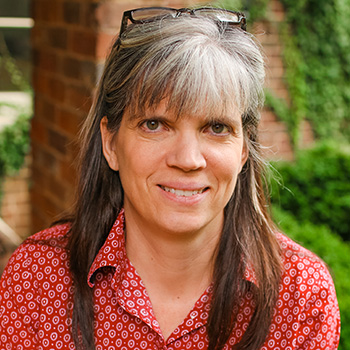Dr. Rachel Collins
Thornhill Professor

Degrees
- B.S., Wildlife and Fisheries Managment, North Carolina State University
- M.S., Department of Zoology, Miami University
- Ph.D., Program in Ecology and Evolution in the Biology Department, University of Pittsburgh
Research & Teaching Interests
- As a community ecologist, I am interested in how organisms in forests interact with each other and with the environment to affect ecosystem function. That includes:
- Species diversity
- Productivity
- Invasibility
- Other dynamics
- I am especially interested in species diversity. Many factors contribute to the number of species in an area and the number of species in an area impact ecosystem functions. You may have noticed that there seems to be some circularity in my description. Although in academic writing one might try to avoid circular arguments, understanding this circular nature of species diversity is key to understanding natural systems. And it is this interplay of the causes and consequences of species diversity that I am most interested in exploring in my research lab and classes.
Publications
- Collins, R.J., C. A. Copenheaver, J.N. Barney, and P.J. Radtke. 2020. Using Invasional Meltdown Theory to Understand Patterns of Invasive Richness and Abundance in Forests of the Northeastern USA. Natural Areas Journal.40: 336-344
- Wise, M and R. Collins. 2020. Using algal microcosms in introductory biology lab I: The influence of nutrient levels on the biodiversity of an ecological community. Bioscene. 46(2): 30-39
- Collins, R. and C. Copenheaver. 2019. Lessons learned from the loss of American chestnut. Virginia Forests. Spring 2019. Pages 16-18.
- Collins, R.J., C.A. Copenheaver, M.E. Kester, E.J. Barker, and K.G. DeBose. 2018. American chestnut: Re-examining the historical attributes of a lost tree. Journal of Forestry. 113: 68-75
- Collins, Rachel, Jerald Dosch, Kristine Hopfensperger, Karen Kuers, Erin Lindquist, Charles McClaugherty, and Tim Menzel. 2016. EREN PFPP Species Composition Curriculum Module with Data. QUBES. https://qubeshub.org/publications/31/2
Available as a Media resource for the following topics
- Biodiversity
- Plant and animal ecology
- Restoration ecology
- Invasive species
- How ecosystems work
- Roanoke College Environment Center
Willing to speak to professional, social or civic groups on
- Value of biodiversity
- How ecosystems work
- Smooth coneflower (Echinacea laevigata) conservation
- Invasive species ecology and management
- Roanoke College Environment Center restoration projects
- Environmental literacy